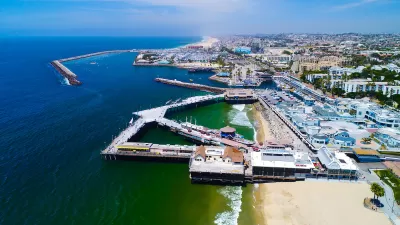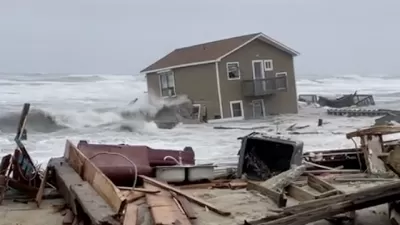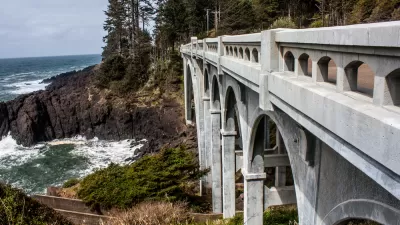In the wake of Hurricane Matthew, a researcher calls attention to the method behind the federal spending on billions of dollars of investment in unsustainable beaches.

Robert S. Young, a professor of coastal geology and director of the Program for the Study of Developed Shorelines at Western Carolina University, takes to the opinion pages of the New York Times to explain the ongoing "beach boondoggle" taking place on the East Coast.
The recent landfall of Hurricane Matthew provides a teachable moment for Young, who notes that the country is responding to the ongoing process of coastal erosion by "trying to hold every shoreline in place forever by pumping sand onto them, largely at federal expense." In fact, a named storm like Hurricane Matthew "can even turn locally funded beach 'nourishment' projects into federally funded ones."
Western Carolina has even created a beach nourishment viewer to illustrate the scale of beach nourishment projects since the early 1990s.
Young argues, however, that the federal funding of beach nourishment is folly. "As sea-level rise continues, and if storms intensify as predicted, the projects will require more sand, and more dollars," he writes. "We are going to run out of both."
While Young acknowledges the arguments in favor of beach nourishment (i.e., "It is true that beach and dune engineering projects benefit local communities. They can protect oceanfront homes and roads while providing a recreational beach for tourists to play on."), he also points out that those benefits are temporary and localized. Moreover, "numerous studies report that the primary beneficiaries of beach stabilization projects are oceanfront property owners."
FULL STORY: The Beach Boondoggle

Planetizen Federal Action Tracker
A weekly monitor of how Trump’s orders and actions are impacting planners and planning in America.

San Francisco's School District Spent $105M To Build Affordable Housing for Teachers — And That's Just the Beginning
SFUSD joins a growing list of school districts using their land holdings to address housing affordability challenges faced by their own employees.

The Tiny, Adorable $7,000 Car Turning Japan Onto EVs
The single seat Mibot charges from a regular plug as quickly as an iPad, and is about half the price of an average EV.

Seattle's Plan for Adopting Driverless Cars
Equity, safety, accessibility and affordability are front of mind as the city prepares for robotaxis and other autonomous vehicles.

As Trump Phases Out FEMA, Is It Time to Flee the Floodplains?
With less federal funding available for disaster relief efforts, the need to relocate at-risk communities is more urgent than ever.

With Protected Lanes, 460% More People Commute by Bike
For those needing more ammo, more data proving what we already knew is here.
Urban Design for Planners 1: Software Tools
This six-course series explores essential urban design concepts using open source software and equips planners with the tools they need to participate fully in the urban design process.
Planning for Universal Design
Learn the tools for implementing Universal Design in planning regulations.
Smith Gee Studio
City of Charlotte
City of Camden Redevelopment Agency
City of Astoria
Transportation Research & Education Center (TREC) at Portland State University
US High Speed Rail Association
City of Camden Redevelopment Agency
Municipality of Princeton (NJ)





























